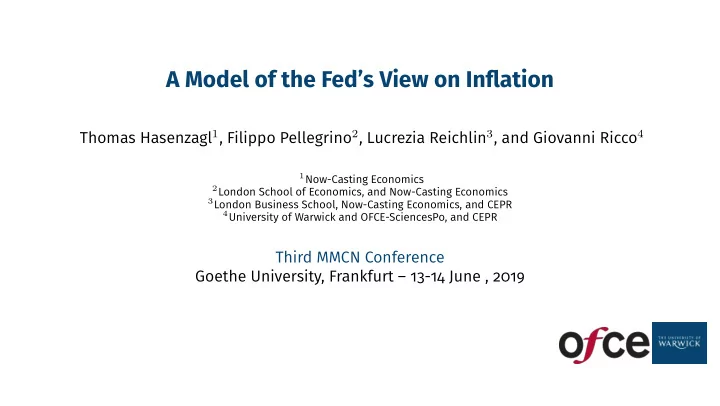

A Model of the Fed’s View on Inflation Thomas Hasenzagl 1 , Filippo Pellegrino 2 , Lucrezia Reichlin 3 , and Giovanni Ricco 4 1 Now-Casting Economics 2 London School of Economics, and Now-Casting Economics 3 London Business School, Now-Casting Economics, and CEPR 4 University of Warwick and OFCE-SciencesPo, and CEPR Third MMCN Conference Goethe University, Frankfurt – 13-14 June , 2019
How Do Policymakers/Median Economist Understand Inflation? � : 2/7
How Do Policymakers/Median Economist Understand Inflation? 1. A Trend in inflation – reflecting long-term expectations � : 2/7
How Do Policymakers/Median Economist Understand Inflation? 1. A Trend in inflation – reflecting long-term expectations 2. The Business cycle – relating economic slack to inflation and inflation expectations Output fluctuates around its output potential Output gap connects to the labour market via Okun’s law and to inflation and inflation expectations via the Phillips curve � : 2/7
How Do Policymakers/Median Economist Understand Inflation? 1. A Trend in inflation – reflecting long-term expectations 2. The Business cycle – relating economic slack to inflation and inflation expectations Output fluctuates around its output potential Output gap connects to the labour market via Okun’s law and to inflation and inflation expectations via the Phillips curve 3. Energy Price disturbances – connect oil price, to expectations and inflation Nonfundamental fluctuations (Coibion and Gorodnichenko, 2015) � : 2/7
How Do Policymakers/Median Economist Understand Inflation? 1. A Trend in inflation – reflecting long-term expectations 2. The Business cycle – relating economic slack to inflation and inflation expectations Output fluctuates around its output potential Output gap connects to the labour market via Okun’s law and to inflation and inflation expectations via the Phillips curve 3. Energy Price disturbances – connect oil price, to expectations and inflation Nonfundamental fluctuations (Coibion and Gorodnichenko, 2015) How do we model this view on inflation ? • A semi-structural unobserved components Trend(s)-Cycle(s) model • Informed by New Keynesian theory • ... employing survey data on inflation • ... encompasses full information rational expectations (FIRE) but allows for deviations � : 2/7
The Model in a Nutshell Stationary ARMA(2,1) Random walk Variable i,t = Cycles i,t Trend i,t + Business Cycle EP Cycle Common Idio Idio Variable Transformation Loads on BC Cycle EP Cycle Common Trend Gross Domestic Product Levels � ✗ ✗ Employment Levels � ✗ ✗ Unemployment Rate Levels � ✗ ✗ WTI Spot Oil Price Levels � � ✗ CPI: All Items YoY � � � Core CPI YoY � � � UoM: Expected Inflation Levels � � � SPF: Expected Inflation Levels � � � � : 3/7
� Trend Inflation : Percent − 2 − 0 2 4 6 1986 1988 1990 1992 1994 1996 1998 Trend: CPI inflation 2000 2002 2004 2006 2008 2010 2012 2014 2016 2018 4/7
� Headline CPI Historical Decomposition of the Cycles : Percent − − 2 0 2 1986 1988 − − 1990 1986 1992 Business cycle 1994 1988 1996 1990 1998 Energy price cycle 1992 2000 CPI inflation 2002 1994 2004 1996 2006 Idiosyncratic cycle 1998 2008 2010 2000 2012 2014 2016 2018 5/7
− Historical Decomposition of the Cycles Core CPI Core CPI inflation 1 0.5 Percent 0 − 0.5 − 1986 1988 1990 1986 1992 1994 1988 1996 1990 1998 2000 1992 2002 1994 2004 1996 2006 2008 1998 2010 2000 2012 2014 2016 2018 Business cycle Energy price cycle Idiosyncratic cycle � : 6/7 −
This Paper • New model explicitly recovering of trends & cycles • Allows for deviations from full information and perfect rationality • Similar to VARs but informed by Economic theory • Does not need tight parametrisation as DSGE models � : 7/7
This Paper • New model explicitly recovering of trends & cycles • Allows for deviations from full information and perfect rationality • Similar to VARs but informed by Economic theory • Does not need tight parametrisation as DSGE models Results : 1. Stable expectational trend � : 7/7
This Paper • New model explicitly recovering of trends & cycles • Allows for deviations from full information and perfect rationality • Similar to VARs but informed by Economic theory • Does not need tight parametrisation as DSGE models Results : 1. Stable expectational trend 2. Sizeable and fairly steep Phillips curve � : 7/7
This Paper • New model explicitly recovering of trends & cycles • Allows for deviations from full information and perfect rationality • Similar to VARs but informed by Economic theory • Does not need tight parametrisation as DSGE models Results : 1. Stable expectational trend 2. Sizeable and fairly steep Phillips curve 3. Oil fluctuations are transmitted to prices � : 7/7
This Paper • New model explicitly recovering of trends & cycles • Allows for deviations from full information and perfect rationality • Similar to VARs but informed by Economic theory • Does not need tight parametrisation as DSGE models Results : 1. Stable expectational trend 2. Sizeable and fairly steep Phillips curve 3. Oil fluctuations are transmitted to prices 4. ... and can overpower the PC 5. some rationalisation of the inflation puzzles � : 7/7
This Paper • New model explicitly recovering of trends & cycles • Allows for deviations from full information and perfect rationality • Similar to VARs but informed by Economic theory • Does not need tight parametrisation as DSGE models Results : 1. Stable expectational trend 2. Sizeable and fairly steep Phillips curve 3. Oil fluctuations are transmitted to prices 4. ... and can overpower the PC 5. some rationalisation of the inflation puzzles � : 7/7
Recommend
More recommend